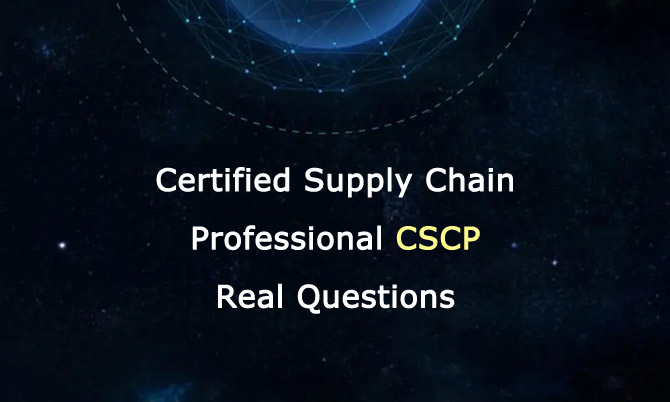Certified Supply Chain Professional CSCP real questions have been updated, which are valuable for you to study the test. Earning your CSCP designation shows that you have the skills to prepare for and overcome disruption, manage risk, and evaluate and implement modern supply chain technologies. All the related APICS CSCP exam information will be helpful in your preparation. To be eligible to take the CSCP exam, a candidate must meet at least one of the following criteria:
Have three or more years of supply-chain-related business experience
Hold a conferred bachelor's degree or an international equivalent
Hold an active CPIM, CPIM-F, CIRM, SCOR-P, CPM, CPSM, CTL, CLTD, CLTD-F or CSM designation

APICS CSCP Exam Information
APICS CSCP exam basic information is available below.
Number of questions: 150
Duration: 3.5 hours
Exam score range: 200 to 350
Test Center: Pearson VUE
CSCP APICS Exam Key Points
CSCP Certified Supply Chain Professional exam key points cover the following details.
Supply Chains, Demand Management and Forecasting
Global Supply Chain Networks
Sourcing Products and Services
Internal Operations and Inventory
Forward and Reverse Logistics
Supply Chain Relationships
Supply Chain Risk
Optimization, Sustainability and Technology
Share some CSCP Real Exam Questions
APICS Certification CSCP real exam questions are the best material for you to study the above Certified Supply Chain Professional exam topics. Share some APICS CSCP real exam questions and answers below.
1.The focus of collaborative supply chain management differs from a transactional approach by its emphasis on the:
A. transportation of goods to the next link in the chain.
B. flow of product information up to the next level of the chain.
C. flow of demand information and cash up the chain.
D. flow of supply into an organization.
Answer: C
2.Which of the following scenarios represents a correct application of the Supply-Chain Operations Reference-model (SCOR)?
A. Sales and marketing refers to SCOR to improve demand generation.
B. Production and engineering uses SCOR best practices to design a new "make" process flow.
C. Distribution and logistics selects suppliers from the SCOR reference list.
D. Marketing and development incorporates SCOR Level I metrics for new product design.
Answer: B
3.The primary objective of supply chain management is:
A. minimizing transportation costs.
B. reducing inventory levels.
C. taking a systems approach.
D. implementing advanced technologies.
Answer: C
4.Which of the following levels in a supply chain network represents the most upstream external activity?
A. Supplier to contractor
B. Manufacturing to supplier
C. Customer to distribution
D. Customer to contractor
Answer: A
5.The design process by which a firm structures and manages the supply chain to achieve optimization is called:
A. an information network.
B. logistical planning.
C. smoothing.
D. network planning.
Answer: C
